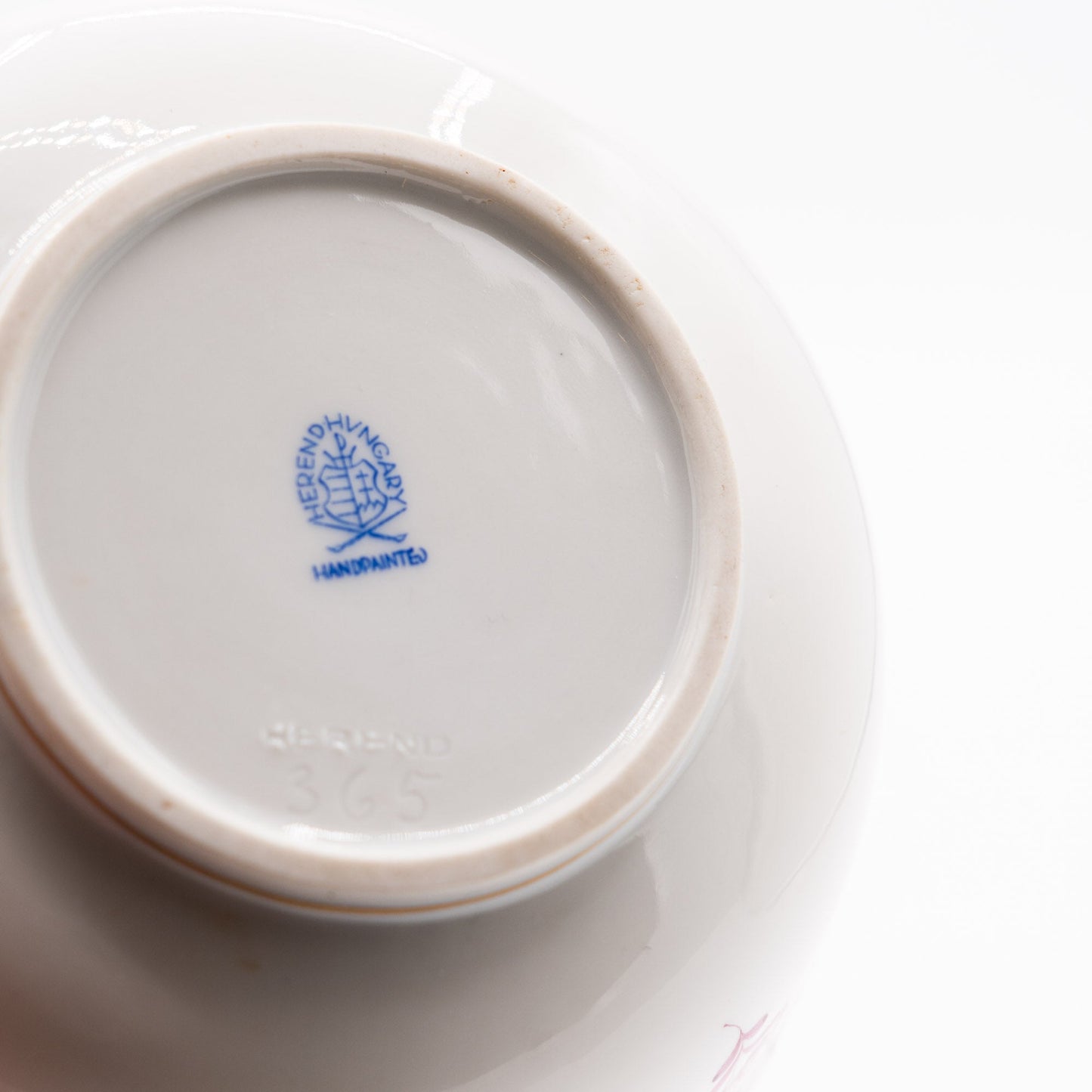Herend
Vintage "Pink Apponyi" Bowl - Herend / Hungary
Vintage "Pink Apponyi" Bowl - Herend / Hungary
Couldn't load pickup availability
A classic of Central-European elegance, this hand-painted Herend “Pink Apponyi” bowl pairs radiant raspberry florals with a finely modelled basket-weave (Osier) relief and a gleaming gilt rim.
The Apponyi pattern - adapted by Herend in the early 20th century from their famous “Indian Basket/Chinese Bouquet” family - celebrates stylised peonies and scrolling leaves, each flower petal shaded by hand.
It’s the shape you reach for daily (fruit, olives, petits fours), yet refined enough to lift a coffee table vignette or a dressing table. A joyful, usable collectible from one of Europe’s premier porcelain houses!
Material: Hard-paste porcelain, hand-painted with gilt rim
Maker: Herend Porcelain Manufactory
Motif: “Pink Apponyi” (raspberry flowers & leaves) with Osier (basket-weave) relief
Style: Classical / Hungarian porcelain, 20th century
Place of Origin: Herend, Hungary
Mark: Blue HEREND HUNGARY Handpainted shield (see base); impressed HEREND 365 (shape code)
Date of Manufacture: Late 20th century to contemporary (based on printed blue Herend shield used post-1948 onward)
Condition: Excellent vintage condition; bright colours and gilding, no chips, cracks or crazing visible. Very minor, honest shelf-marks and a tiny kiln-speck to the inner rim from firing, noted for accuracy (see photos).
Share
- Worldwide Shipping
- Secure Packaging
- Loving Curation





Origin & Maker
Founded in 1826 in the village of Herend by Vince Stingl and transformed under Mór Fischer from 1839, Herend grew from a small workshop into one of Europe’s most celebrated makers of hand-painted, hard-paste porcelain. International acclaim followed the Great Exhibition in London (1851) and subsequent world fairs, where Herend’s virtuoso painting and rich gilding attracted royal patrons, including Queen Victoria—whose 1851 order gave the famous “Victoria” butterfly-and-peony pattern its name—as well as the Austro-Hungarian court and the Rothschilds (inspiring the charming “Rothschild Bird” design).
Herend’s signature lies in its entirely hand-decorated surfaces: layered enamels, 24-carat gilded details and exquisitely fine outlines. Iconic motifs include Apponyi (a pared-back take on Victoria), the Fishnet/Fish-scale decoration (now synonymous with Herend figurines), and a broad repertoire of Oriental-inspired florals and fauna. Despite nationalisation in the 20th century, the manufactory safeguarded its artisan training and, since privatisation in 1993, continues to produce table services and figurines that marry courtly tradition with meticulous craftsmanship.
Today, collectors prize Herend for its painterly detail, depth of colour, and continuity of hand-work—each piece signed by the artist—making it one of the few European porcelain houses where the 19th-century atelier spirit still defines contemporary production.
Blog posts
View all-

A Serendipitous Morning at the Rue de Bretagne ...
There are few joys in life that match the thrill of stumbling upon a hidden treasure, and for me, flea markets hold that magical allure. One of my favourite flea...
A Serendipitous Morning at the Rue de Bretagne ...
There are few joys in life that match the thrill of stumbling upon a hidden treasure, and for me, flea markets hold that magical allure. One of my favourite flea...
-

Emile Bourgeois and "Le Grand Dépôt" in Paris
Recently, I found this stunning Sarreguemines wash set. It was at the Brocante in Belfort, France. On this day, we had got up at 4 AM to be there in...
Emile Bourgeois and "Le Grand Dépôt" in Paris
Recently, I found this stunning Sarreguemines wash set. It was at the Brocante in Belfort, France. On this day, we had got up at 4 AM to be there in...
-

The Legacy of Robert Haviland: A Journey from N...
The story of Robert Haviland porcelain is one of artistry, transatlantic ambition, and enduring heritage. It begins in the mid-19th century when David Haviland, an enterprising New Yorker, founded Haviland...
The Legacy of Robert Haviland: A Journey from N...
The story of Robert Haviland porcelain is one of artistry, transatlantic ambition, and enduring heritage. It begins in the mid-19th century when David Haviland, an enterprising New Yorker, founded Haviland...








